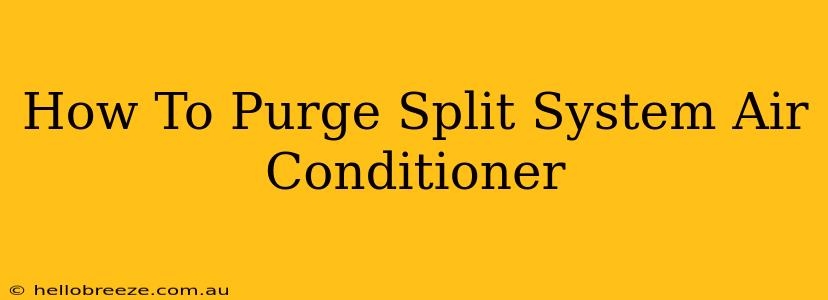Split system air conditioners are a popular choice for home cooling, offering efficient and reliable performance. However, like any system, they require regular maintenance to ensure optimal functionality. One crucial aspect of this maintenance is purging the system of contaminants. This guide will walk you through the process of purging a split system air conditioner, helping you maintain its efficiency and longevity.
Understanding the Importance of Purging Your Split System AC
Before we dive into the how-to, let's understand why purging is so important. Over time, your split system AC can accumulate non-condensables—air and other gases that shouldn't be in the refrigerant lines. These contaminants can:
- Reduce cooling efficiency: Non-condensables interfere with the refrigerant's ability to absorb heat, leading to weaker cooling and higher energy bills.
- Damage the compressor: These contaminants can damage the compressor, a crucial and expensive component of your AC unit. Compressor failure can lead to costly repairs or even replacement.
- Cause leaks: In some cases, contaminants can contribute to refrigerant leaks, further reducing efficiency and increasing repair needs.
Regular purging helps prevent these issues, keeping your AC running smoothly and efficiently for years to come.
Tools and Materials You'll Need
Before you begin purging your split system air conditioner, ensure you have the necessary tools and materials:
- Refrigerant recovery machine: This is essential for safely recovering the refrigerant from the system. Improper handling of refrigerant can be dangerous and illegal.
- Vacuum pump: Used to evacuate the system of air and moisture.
- Manifold gauge set: Allows you to monitor the pressure and temperature of the refrigerant.
- Nitrogen tank: Provides a clean, inert gas for purging the system.
- Appropriate hoses and connectors: Ensure compatibility with your system and equipment.
- Safety glasses and gloves: Always prioritize safety when working with refrigerants and AC systems.
Note: This process requires specialized knowledge and equipment. If you are not comfortable performing this task yourself, it is strongly recommended that you contact a qualified HVAC technician.
Step-by-Step Guide to Purging Your Split System Air Conditioner
Warning: This process involves working with refrigerants and high-pressure systems. Incorrect procedures can lead to injury or damage. If you're not experienced, call a professional.
-
Safely recover the refrigerant: Using your refrigerant recovery machine, carefully recover all refrigerant from the system. This is crucial for both environmental protection and your safety.
-
Evacuate the system: Connect your vacuum pump to the system and evacuate it to a deep vacuum (typically below 500 microns). This removes air, moisture, and other contaminants. The vacuum time will depend on the system size and the level of contamination.
-
Purge with nitrogen: Once a deep vacuum is achieved, introduce nitrogen into the system. This pushes out any remaining contaminants. Use the manifold gauge set to monitor the pressure.
-
Repeat the evacuation and purge process: Repeat steps 2 and 3 multiple times to ensure thorough cleaning of the system.
-
Recharge the system with refrigerant: Once you're satisfied the system is clean, recharge it with the appropriate amount of refrigerant using your manifold gauge set to monitor pressure and temperature. Refer to your system's specifications for the correct amount of refrigerant.
-
Test the system: After recharging, test the system to ensure it's operating correctly and that there are no leaks.
When to Call a Professional
While this guide provides a general overview, purging a split system AC is a complex task. If you are not comfortable working with refrigerants and high-pressure systems, you should contact a qualified HVAC technician. Improper procedures can lead to damage, injury, and environmental harm. Professional technicians have the training, experience, and equipment to perform this task safely and effectively. The cost of professional service is far less than the potential cost of repairing damage caused by a DIY mistake.
Maintaining Your Split System Air Conditioner for Optimal Performance
Purging your split system AC is just one part of proper maintenance. Remember to also:
- Change air filters regularly: This improves airflow and efficiency.
- Inspect coils for dirt and debris: Clean them as needed to maintain optimal heat transfer.
- Schedule regular professional maintenance: A yearly inspection by a qualified technician can identify and address potential issues before they become major problems.
By following these guidelines and performing regular maintenance, you can ensure your split system air conditioner operates efficiently and reliably for many years to come. Remember, safety is paramount, so don't hesitate to call a professional if you have any doubts or concerns.

